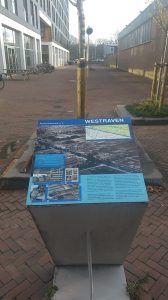Westraven
Westraven's roots lay across the Vaartse Rijn (1661). Already in 1844, this place became useful for various labours. Ravesteyn on the Jutfaseweg with the production of hand-painted Old Dutch tiles. In 1920 the company, now expanded with pottery and building ceramics, was moved to Helling 112. Hard-working professionals and artists ensured growth and prosperity and export to many countries.
Millions of pieces of pottery were produced. The “golden roof tiles” for a domed mausoleum in Haifa were exceptional. Every Dutch family had or has something from Westraven in their home. In 1923 started pressing decorative relief tiles. After 1930, the pottery department expanded considerably and collaborated with artists such as Cris Agterberg. After the war, the Utrecht graphic artist Koos van der Sluijs was given the space to experiment with tile designs.
Due to decreasing demand for handicraft products, the factory ran into problems in the 1960s. The factory was taken over by de Porceleyne Fles and was demolished in 1985.

